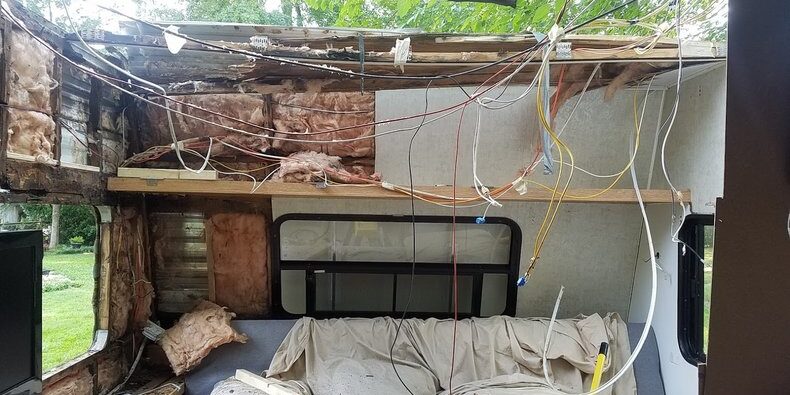When it comes to maintaining your camper, ensuring that the roof stays in top condition is paramount. A damaged roof can lead to costly repairs, uncomfortable living conditions, and even serious structural issues. If you’re a camper owner, understanding how to properly repair and maintain your roof will save you time, money, and stress in the long run. Whether you’re dealing with leaks, cracks, or wear and tear, proper roof care ensures your camper stays dry and secure during your adventures.
In this blog, we’ll cover essential tips and techniques to help you with camper roof repair, focusing on the importance of maintenance, the types of repairs, and how to properly protect your camper roof for lasting durability.
Why Camper Roof Repair is Important
Your camper roof is the first line of defense against the elements. Whether you’re traveling through rain, wind, or snow, the roof shields your interior from water damage and weather-related wear. Any damage to your camper roof can result in leaks that lead to mold, rot, and costly repairs. If left unattended, even small issues can escalate into major structural problems that compromise the safety and comfort of your camper.
Regular camper roof inspections and maintenance are crucial to catch any issues before they turn into more significant problems. If you notice water spots, stains, or cracks, it’s a good idea to take action before further damage occurs. Quick roof repairs help preserve your camper’s integrity and protect your investment.
Signs You Need to Repair Your Camper Roof
Knowing when to repair your camper roof is essential. Many issues can be caught early with regular inspections. Here are a few common signs that your camper roof might need attention:
- Leaks and Water Damage: Leaks are one of the most obvious signs that your roof needs repair. If you notice water spots on the ceiling or walls of your camper, it’s likely that your roof has developed a leak. Even a small leak can worsen over time, leading to significant damage to the interior of your camper.
- Cracks or Tears: Cracks or tears in the roof material are also signs that repairs are needed. These can be caused by weather, age, or even improper maintenance. Cracked roofing materials allow water to seep through, creating long-term issues.
- Roof Blisters or Bubbles: If you notice blisters or bubbles forming on your camper roof, it could be an indication of trapped moisture or poor ventilation. These areas can become weak points in the roof structure and lead to leaks or further damage.
- Visible Damage to Seals and Caulking: The caulk and seals around vents, skylights, and seams are vital for preventing water from entering your camper. Over time, they can crack or peel away, leaving gaps that allow water to seep in.
- Sagging Roof: A sagging roof may indicate structural damage or water infiltration over time. This could be a serious issue, as it can lead to significant damage to the internal structure of your camper. If your roof is sagging, it’s essential to have it repaired immediately.
Step-by-Step Camper Roof Repair Process
When it comes to repairing your camper roof, there are several steps involved to ensure the repair is done properly. Here’s a step-by-step guide to help you get started:
- Clean the Roof Surface: Before you begin repairs, ensure that the roof is clean and free from debris. Dirt, leaves, and other debris can interfere with the effectiveness of your repair materials. Use a broom or a soft-bristled brush to remove any dirt and debris. If needed, wash the surface with mild soap and water.
- Inspect the Roof for Damage: Thoroughly inspect your roof for signs of damage, including cracks, leaks, or areas where the material has worn away. Pay close attention to the seams, corners, and joints, as these areas are most prone to leaks.
- Patch Any Cracks or Holes: If you find cracks or small holes in the roof, patch them up using a suitable roofing sealant or patching material. For RVs with rubber roofs, consider using a rubberized roof patching compound. For campers with metal roofs, a metal patch and appropriate sealant may be needed.
- Reapply Sealant to Seams and Joints: Seams, edges, and joints are the most common places where leaks occur. Check the caulking and sealant around vents, skylights, and air conditioning units. If any of the sealant is cracked, peeling, or missing, remove the old material and apply a fresh layer of high-quality sealant.
- Re-coat the Roof Surface: Once any necessary patches and sealants are applied, consider re-coating the entire roof to protect it from UV rays, rain, and other environmental factors. Roof coatings are available for both rubber and metal roofs and help extend the life of your camper roof. These coatings also improve water resistance, preventing future leaks.
- Check for Proper Drainage: Ensure that your camper’s roof has proper drainage. Blocked drainage can cause water to pool on the roof, leading to damage over time. Clear out any gutters, downspouts, or drains that may be clogged with debris.
Choosing the Right Roof Repair Materials
Selecting the correct materials for camper roof repair is crucial to ensuring the longevity of the repair. The material you choose will depend on the type of roof your camper has. Common camper roof types include rubber, metal, and fiberglass. Below are the best materials for each type:
-
Rubber Roofs: Use a rubberized patching compound or EPDM roofing repair kit specifically designed for rubber roofs. Rubber roofs need materials that are flexible and waterproof to ensure a proper seal.
-
Metal Roofs: For metal roofs, use metal roofing patches or aluminum-based sealants. These materials bond well with metal surfaces and provide a long-lasting seal.
-
Fiberglass Roofs: For fiberglass roofs, use a fiberglass resin or epoxy repair kit. These materials bond securely with the fiberglass surface and are ideal for reinforcing damaged areas.
Be sure to choose high-quality materials that are designed for outdoor use and can withstand harsh weather conditions. Low-quality materials may not last long and can lead to further damage.
Maintaining Your Camper Roof for Longevity
Proper maintenance can significantly extend the life of your camper roof. Regular inspections and timely repairs help prevent minor issues from turning into expensive repairs. Here are a few maintenance tips to keep your camper roof in optimal condition:
-
Inspect Regularly: At least twice a year, inspect your camper roof for signs of wear and tear. Perform additional inspections after heavy storms or extreme weather conditions.
-
Keep It Clean: Clean your camper roof regularly to prevent debris from accumulating. Dirt and leaves can trap moisture and cause damage to the roof’s surface.
-
Apply Roof Coating: Reapply roof coatings every few years to ensure that the surface is protected from UV rays, rain, and other elements. This will help keep the roof in good condition and prevent cracks from forming.
-
Check Seals and Caulk: Regularly check the seals and caulking around vents, air conditioning units, and other roof components. Reapply sealant as needed to prevent leaks.
-
Address Problems Early: Don’t wait until there’s a significant issue. Address minor leaks, cracks, or tears immediately to prevent further damage.
Conclusion
Camper roof repair is essential for maintaining the integrity of your vehicle and ensuring a safe, dry, and comfortable living space. Regular inspections, prompt repairs, and proper maintenance can significantly extend the life of your camper roof and prevent costly damages in the future. Remember to use the right materials for repairs and choose high-quality products that will withstand the elements. If you’re unsure about repairing your camper roof yourself, consider reaching out to a professional roofer who specializes in camper roofs. By taking care of your camper roof, you’ll enjoy many more adventures with peace of mind.







